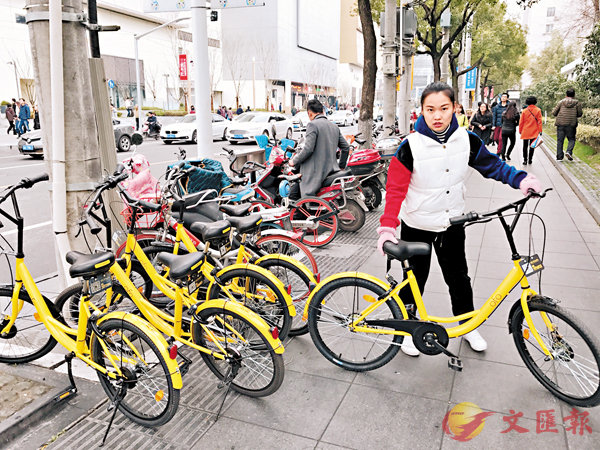 ■上海街頭的共享單車。 資料圖片
■上海街頭的共享單車。 資料圖片【原文】下文摘錄自香港《文匯報》2017年3月21日報道:
在「老字號」(time-honored)車企「飛鴿」(Flying Pigeon)的生產車間,各條生產線(production line)上都是一派熱火朝天的景象:從車輪到車架,一條幾十米長的流水線(assembly line)下來,一輛「共享單車」(shared-bike)就包裝好,可以出廠了。共享單車作為近來興起的一種「互聯網+交通」(internet plus traffic)的新業態,在滿足市民出行「最後一公里」需求的同時,也有力帶動了傳統單車製造企業的發展。
天津今年料產一千萬輛
「幹了一輩子單車,也沒想過單車會有今天」,天津市單車電動車行業協會(Tianjin Municipal Bicycle Industry Association)理事長劉學權說。從去年上半年到現在,內地共享單車已發展到29個品牌,投入市場的總量超過300萬輛。「共享單車『激活』(bring momentum to)了一批傳統單車製造企業(manufacturing industry)。」
據了解,作為內地最大的單車生產製造基地,天津有一定規模的(sizable)單車企業,如飛鴿、富士達(Fushida)、愛瑪(Aima)等都參與了共享單車的設計和製造,並從中受益。據天津市單車電動車行業協會統計,截至今年2月,天津共生產共享單車200餘萬輛,預計2017年天津將生產約1,000萬輛。
第三方數據研究機構比達諮詢(BigData-Research)發佈的《2016中國共享單車市場研究報告》顯示,截至2016年底,共享單車市場整體用戶數量已達到1,886萬,2017年預計年底將達5,000萬用戶規模。
業內人士:將取代輕便單車
同時,共享單車的快速發展衝擊着傳統單車產品市場。業內人士分析認為,共享單車將持續取代(substitute)現在的城市輕便單車;未來,內地單車市場的總需求量將會有所下降。尤其對那些沒有研發(research and development)能力、拿不到共享單車訂單(order)的中小型企業,更是生存的挑戰。
一位業內人士透露,行業裡一些中小企業已經沒有活幹了,有的在找大企業尋求合作(cooperation),有的去找共享單車運營公司談判(negotiate),但效果都不理想。
在一些傳統的單車銷售門店,與火爆街頭的共享單車相比,生意顯得格外冷清。一位門店的銷售人員告訴記者:「滿大街都是共享單車,我們這裡幾乎沒人光顧了,一周還沒賣出去一輛車。」
另一方面,一些業內人士對共享單車的未來感到樂觀(optimistic)。劉學權表示,按目前共享單車的投放範圍(scope)來看,全國總需求量初步估計在2,000萬輛左右,「以每輛車平均每天5人次使用計算,產品使用壽命約為2年,未來每年將會產生1,000萬輛的修補(repair / maintenance)市場。」
20 million shared-bikes expected to come in China
【譯文】At the factory of the time-honored bicycle manufacturer Flying Pigeon, the production lines were going full throttle-having gone through an assembly line from the components of the wheel to the frame with several tens of meters long, the production of a brand-new shared-bike was almost complete. Being a new form of "internet plus traffic" industry, the booming bike-sharing services not only facilitate people's traveling of the "last kilometre", but also inject impetus to the development of the traditional bike-making industry.
Tianjin to produce 10 million
The director of the Tianjin Municipal Bicycle Industry Association Liu Xuequan said that he had been engaging in the bicycle industry for his lifetime but could hardly image it would have evolution like nowadays. Since the first half of last year until now, there have been 29 different bike-sharing suppliers in the market with a total of three million shared-bikes being put into operation. "This is bringing some momentum to the traditional bicycle manufacturing industry," said Liu.
As the largest bicycle manufacturing base in China, some sizable enterprises such as Flying Pigeon, Fushida and Aima have been involved in the design and production of shared-bikes and benefiting from this emerging industry. According to the Tianjin Municipal Bicycle Industry Association, over two million bikes were produced in the first two months this year, and the number is expected to reach 10 million at the end of 2017.
A report issued by a third party market consultancy BigData-Research estimated that there were 18.86 million shared-bicycle users at the end of 2016, and the number might greatly expand to 50 million by the end of this year.
Insider: will displace ordinary bikes
However, the rapid growth of bike-sharing might pose a threat to the traditional bike market. It is predicted that shared-bikes will gradually displace ordinary bicycles used by city dwellers, and the total market demand for bicycles will tend to decline in the future. The situation would be especially challenging for small and medium-sized firms with limited research and development capability and few orders from bike-sharing companies.
When small and medium bike-makers are suffering, some of them start to seek cooperation with big enterprises and some consider having negotiation with bike-sharing providers, but it is still hard to achieve favourable outcomes.
Compared with the spawning industry, most traditional bike sellers are having difficult times boosting up their business. "Shared-bikes are found everywhere. We can hardly find a potential bicycle buyer nowadays and even no sales are recorded in weeks," a salesperson told the reporters.
On the other hand, some people are optimistic about the future of the bike-sharing services. Liu said that based on the current scopes covered by the bike-sharing industry, the demand of shared-bikes in China would be estimated at around 20 million." A bike has a two-year service life on average if five users ride it per day; consequently, at least 10 million bikes would need repairs each year and a great market of maintenance services would hence be created," said Liu.■龐嘉儀
Q&A
1. 共享單車的收費大概是多少?
2. 比達諮詢的調查顯示,現時哪個品牌的市場佔有率最高?
3. 承上題,這個品牌的市場佔有率約為多少?
4. 共享單車服務響應了什麼環保概念?
5. 除了共享單車,內地還推出了什麼共用服務?
1. 半小時人民幣5毛至1元
2. ofo
3. 51.2%
4. 「綠色出行」(green travel)
5. 共享電單車(shared-motorbike)、共享電動車(shared-electric car)

